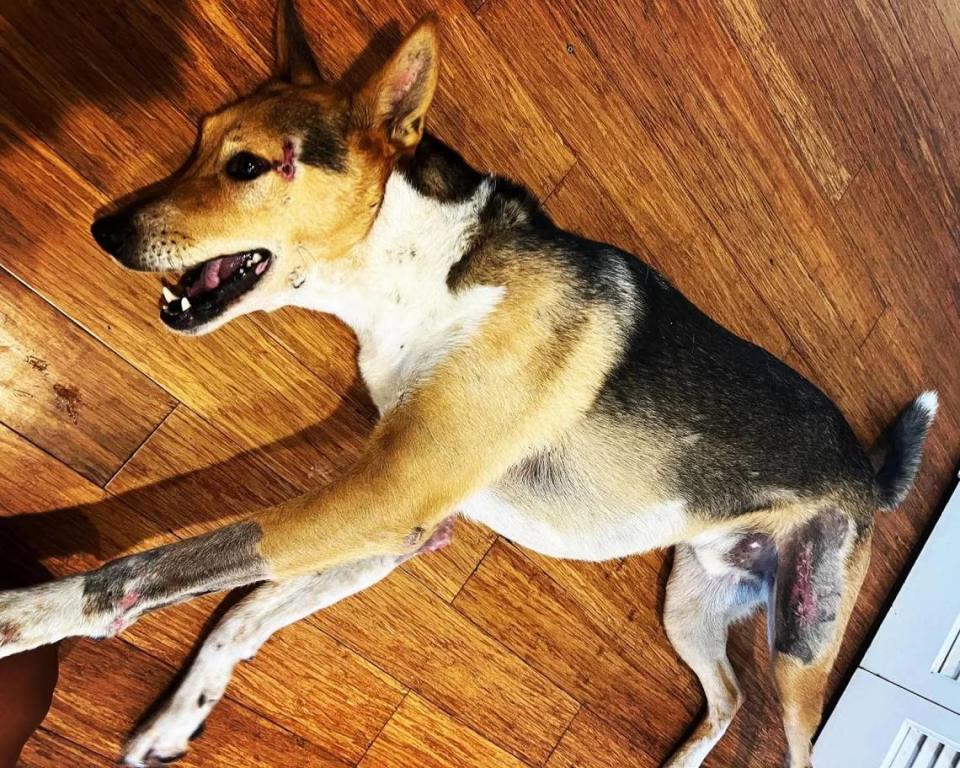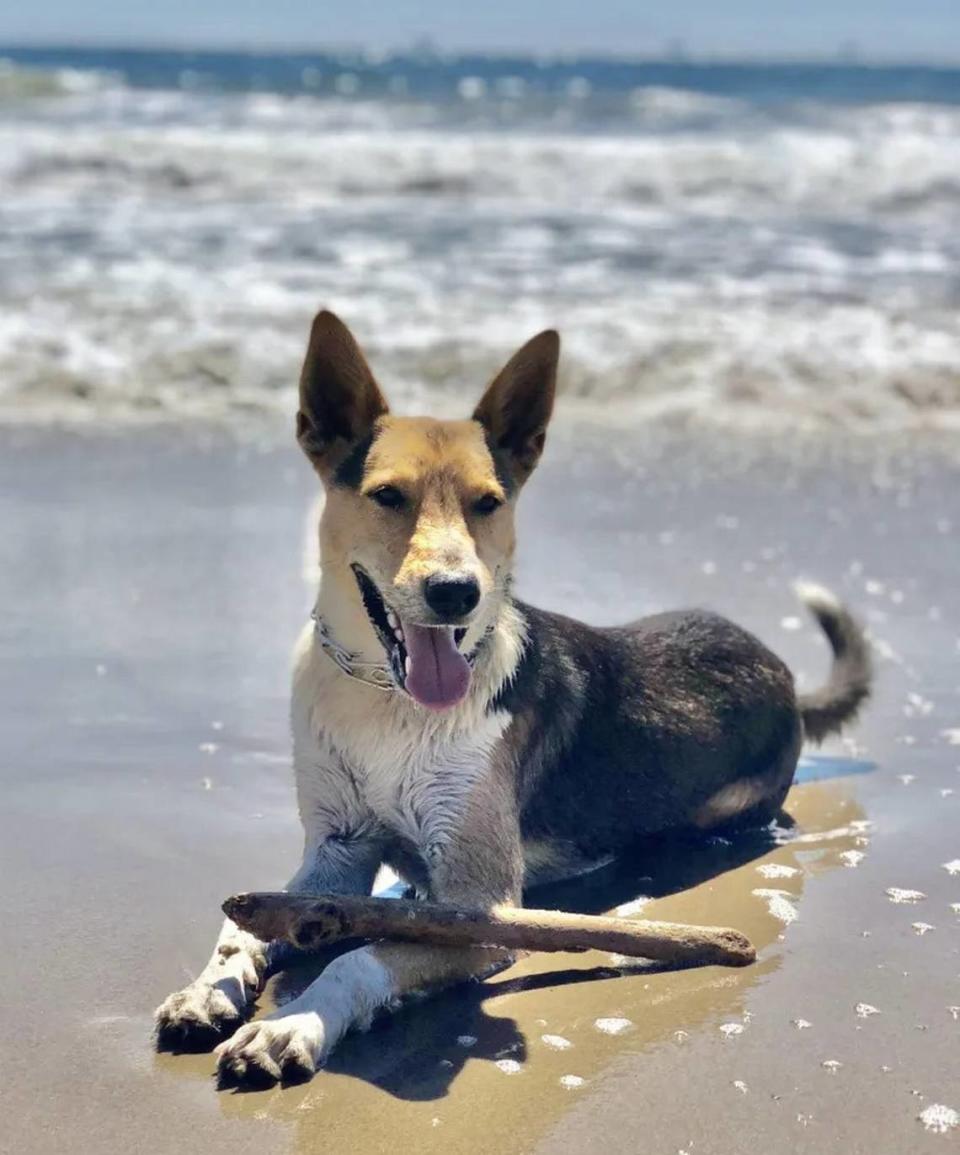Central Coast dog lost in the Sierra during family trip to Mammoth. Here’s how he got home
A Central Coast dog’s trip to Mammoth Lakes wasn’t the greatest of vacations.
In fact, Jackson is lucky to be alive after a harrowing week-long ordeal that left him lost and alone, riddled with bite wounds, and on the brink of death in the Eastern Sierra.
“I still can’t believe my dog survived,” Ashlan Alldredge, the dog’s owner, said while watching Jackson play at his home weeks after the dramatic discovery of the nearly lifeless animal in a remote mountain area near Mammoth Lakes.
The Alldredge family had been looking forward to what was supposed to be a fun and relaxing vacation in late July.
Alldredge had taken time off from his job at the Santa Barbara Fire Department to enjoy the mountain country with his wife, Jennifer, and their two young daughters, June and Polly.
But just two days in, things went terribly wrong.
After a 30-minute drive from Mammoth Lakes to June Lake, the family realized Jackson was no longer in the back of the truck.
“I started calling for him,” Alldredge told Noozhawk. “Nothing.”
Still, they knew Jackson was wearing a collar and hoped they would find him quickly.
They also took comfort in the fact that they had vacationed here several times before, and Jackson was somewhat familiar with the area.

Central Coast family’s dog goes missing during trip
The Alldredges adopted Jackson, a German shepherd/cattle dog mix going on 5 years old, from a rescue in Paso Robles when he was just a few months old.
“He is really smart; he’s a herding dog,” Alldredge explained. “He is one of those dogs who’s with you wherever you go. He’s not a dog who’s ever run away.”
The family drove back and forth between the two towns and got out to look in places where he might have jumped out.
But minutes turned into hours, and there was no sign of their beloved pet.
“As the day progressed, it started getting a lot more serious,” Alldredge said. “The kids were asking a lot of questions, and I was trying to keep them calm.”
Posters with a photo of the missing dog were distributed along the Highway 395 corridor between Bishop and Bridgeport, and Jennifer Alldredge began a social media campaign to spread the word.
It wasn’t long before tips started coming in, but they usually offered false hope.
Since Jackson’s coloring is predominantly tan, many potential sightings of him turned out to be deer. His stature and features also resembled a coyote, causing more well-intentioned mix-ups.
Later that week, the family agreed that Jennifer and the girls should return home to the Central Coast while Ashlan stayed to focus on the search. With their furry family member missing, the vacation was over.

Santa Barbara firefighter searches Mammoth Lakes for pet
Alldredge spent the rest of the week living out of his truck, surviving off of granola bars and other snacks, following every lead that came in by phone or social media. His brother-in-law joined the effort for a few days.
Jennifer continued to field tips from home and relayed them to her husband, who became quite familiar with the many trails and dirt roads in the area as he searched for Jackson.
About 90% of the areas he traveled were off-road access.
He encountered campers and people living off-grid. Although initially uninterested in visitors, once they heard the word “dog” they usually perked up and were eager to help.
“I made probably 300 fliers at a little place in Mammoth,” Alldredge said. “I put them up on trails, city streets, campgrounds — everywhere.”
Businesses, hotels and campgrounds in the area were supportive and shared the posters and social media postings, which led to a lot of well-intentioned but false reports, causing Alldredge to spend hours and hours driving from one spot to another based on tips.
However, a few of the reports from throughout the week mentioned the same location: a Caltrans work station.
Alldredge frequented the area and tried to lure Jackson back to his truck with the scent of his dog bed and dog food.
“That meant that every morning I woke up to a herd of deer around the back of my truck,” he recalled. “I also saw two little black bears, lots of coyotes, but never my dog.”
A few times Alldredge saw turkey buzzards circling overheard, and he feared the worst. However, the meal they were honing in on always turned out to be wildlife.
Day after day of sleeping in his vehicle was physically and mentally exhausting, but Alldredge could not think about going home without his canine companion.
After a full week of searching, though, he knew that he would have to return home soon to go back to work.
“It was gut wrenching,” he recalled.

U.S. Forest Service worker finds missing dog
It was on the seventh and final day of the search while following up on a tip in Mammoth Lakes that he got a phone call from a U.S. Forest Service worker who claimed to have eyes on Jackson.
Having been disappointed so many times already, Alldredge asked him, “Do you think you see him, or do you see him?”
That employee, Tanner Wenzel, told Alldredge he was looking right at Jackson and that he was certain it was the missing dog because he had just seen one of his posters on the way up to the work site.
The off-highway vehicle technician commented to his co-worker, Karla Destephen, how the dog’s chances of surviving this long in the wild were slim, but moments later Destephen spotted Jackson.
“I kind of ate my words,” Wenzel recalled.
Jackson was lethargic and uninterested in food. Although he drank the water that Wenzel offered him, he was unable to keep it down — a sign of dehydration.
Some wounds were visible on Jackson’s head, but the forest service workers dared not move him and didn’t see the other injuries all over his body.
“He’s right underneath this cell phone tower, and he’s not looking very good,” Wenzel reported to Alldredge on the phone.
So Alldredge raced up to Wenzel’s location, which was not easily accessible. He had to use four-wheel drive, nearly got stuck twice, then hiked the rest of the way.
“The second I got up there, I expected my dog to run toward me,” Alldredge said. “He barely lifted his head. I could tell he was severely dehydrated.”
Wenzel said watching the reunion was a tear-jerking experience because the dog clearly recognized Alldredge, but he was in such bad shape.
“I grabbed him like a baby and carried him all the way to my car,” Alldredge recounted.
Despite the reunification, Alldredge was far from relieved. He tried to shield his family from the reality of the dog’s condition, which was dire.
Alldredge called Jennifer to let her know he had Jackson. She, in turn, called ahead to a small veterinary clinic in Mammoth Lakes to ensure someone could see him right away.
Fortunately, the staff there was able to do some preliminary treatment, including getting fluids into Jackson with an IV.
Later that day, Jackson was transferred to a larger veterinary clinic in Bishop. The vet from Mammoth Lakes even accompanied him there.
That vet, Dr. Taylor Ludwick, turned out to be a Santa Barbara native, having graduated from Santa Barbara High School and Westmont College prior to attending UC Davis School of Veterinary Medicine.

Dog was dehydrated, attacked by coyotes before rescue
The veterinarians agreed that Jackson likely had been attacked by a large pack of coyotes, and that he had been without water for at least four days, Alldredge said.
Daytime temperatures had been in the 90s much of that time.
In addition to the visible wounds, he was battling an infection in his blood. His liver and kidneys were showing signs of shutting down.
The priority was getting Jackson hydrated. Veterinary staff initially could not close up wounds with sutures because the dog was still in shock.
Alldredge, meanwhile, checked into a local motel and was able to get his first shower and real meal in a week.
The veterinarian in Bishop allowed him to spend as much time with Jackson in the clinic as he wanted.
Finally, Jackson started to respond to his human.
“Him recognizing me and not wanting me to leave was awesome but also heartbreaking, too,” Alldredge recalled.
The clinic worked to ensure a seamless transition to Jackson’s veterinarian back in Carpinteria, where he continued treatment, including four different antibiotics.
Just two weeks later, on Aug. 11, Jackson’s sutures were removed and he was declared fully recovered — much to his family’s surprise and relief.
“He is, amazingly, 100% the same dog,” Alldredge said. “He is barking at neighbors, chasing squirrels. … To have him back with the family and kids, we are so lucky. He’s an amazing dog.”


